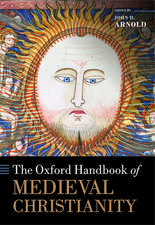Belief and Unbelief in Medieval Europe
Autor Prof. John H. Arnolden Limba Engleză Paperback – 29 iun 2005
Preț: 229.07 lei
Nou
Puncte Express: 344
Preț estimativ în valută:
43.84€ • 45.51$ • 36.55£
43.84€ • 45.51$ • 36.55£
Carte tipărită la comandă
Livrare economică 22 martie-05 aprilie
Preluare comenzi: 021 569.72.76
Specificații
ISBN-13: 9780340807866
ISBN-10: 0340807865
Pagini: 328
Dimensiuni: 156 x 234 x 22 mm
Greutate: 0.59 kg
Editura: Bloomsbury Publishing
Colecția Bloomsbury Academic
Locul publicării:London, United Kingdom
ISBN-10: 0340807865
Pagini: 328
Dimensiuni: 156 x 234 x 22 mm
Greutate: 0.59 kg
Editura: Bloomsbury Publishing
Colecția Bloomsbury Academic
Locul publicării:London, United Kingdom
Caracteristici
Explores the central issue in medieval society: what role did religion really play?
Notă biografică
John H. Arnold is Professor of Medieval History at Birkbeck College, University of London. He is also the successful author of History: A Very Short Introduction.
Recenzii
'... by focusing on the laity over and extended period of time, he is able to highlight the multiple meanings, functions and even levels of religious belief (or unbelief) in medieval society. In so doing, Arnold presents a much more complicated picture of the so-called 'Age of Faith', and one which will be welcomed by specialist and student audiences alike.'
'This is an ambitious book. In it, John H. Arnold presents a new and challenging way of interpreting the history of lay religious practices between 1000 and 1500 and the ways in which those practices interacted with the official positions of the church hierarchy.'
'This is an ambitious book. In it, John H. Arnold presents a new and challenging way of interpreting the history of lay religious practices between 1000 and 1500 and the ways in which those practices interacted with the official positions of the church hierarchy.'
Descriere
Exactly what role did religion play in Europe in the Middle Ages?; Was medieval society really as devout as we think?; John Arnold looks beneath the surface and finds a much more complex and interesting picture than conventional wisdom suggests.











